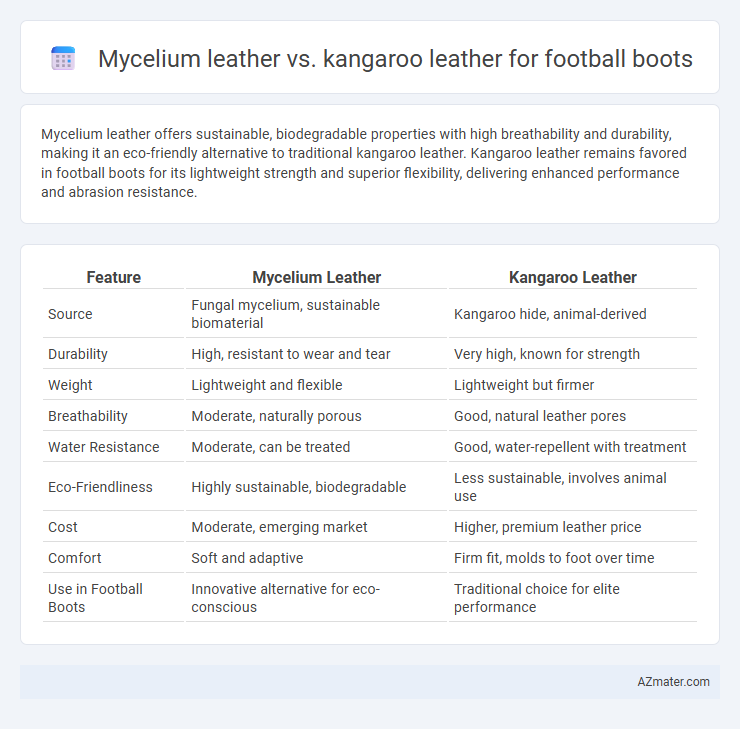Mycelium leather offers sustainable, biodegradable properties with high breathability and durability, making it an eco-friendly alternative to traditional kangaroo leather. Kangaroo leather remains favored in football boots for its lightweight strength and superior flexibility, delivering enhanced performance and abrasion resistance.
Table of Comparison
| Feature | Mycelium Leather | Kangaroo Leather |
|---|---|---|
| Source | Fungal mycelium, sustainable biomaterial | Kangaroo hide, animal-derived |
| Durability | High, resistant to wear and tear | Very high, known for strength |
| Weight | Lightweight and flexible | Lightweight but firmer |
| Breathability | Moderate, naturally porous | Good, natural leather pores |
| Water Resistance | Moderate, can be treated | Good, water-repellent with treatment |
| Eco-Friendliness | Highly sustainable, biodegradable | Less sustainable, involves animal use |
| Cost | Moderate, emerging market | Higher, premium leather price |
| Comfort | Soft and adaptive | Firm fit, molds to foot over time |
| Use in Football Boots | Innovative alternative for eco-conscious | Traditional choice for elite performance |
Introduction to Mycelium and Kangaroo Leather
Mycelium leather, derived from fungal root structures, offers a sustainable and eco-friendly alternative to traditional leather, exhibiting durability and flexibility ideal for football boots. Kangaroo leather, renowned for its lightweight strength and exceptional tensile properties, provides superior ball control and comfort, making it the preferred material in premium football boot manufacturing. Comparing these materials highlights the innovative potential of mycelium leather against the established performance benefits of kangaroo leather in sports footwear.
Sustainability: Mycelium vs Kangaroo Leather
Mycelium leather offers a highly sustainable alternative to traditional kangaroo leather by requiring significantly less water, land, and chemical inputs during production, and it decomposes naturally, reducing environmental impact. Kangaroo leather, while durable and lightweight, involves ethical concerns related to wildlife management and habitat disruption, along with a carbon footprint tied to animal agriculture. Choosing mycelium leather for football boots supports circular economy principles and reduced ecological strain compared to conventional kangaroo leather sourcing.
Material Strength and Durability Comparison
Mycelium leather exhibits high tensile strength and resistance to abrasion, making it a sustainable yet durable alternative for football boots. Kangaroo leather is renowned for its exceptional toughness and lightweight properties, offering superior durability and flexibility under rigorous play conditions. While Mycelium leather provides biodegradability and comparable strength, Kangaroo leather remains the preferred choice for long-lasting, high-performance football boot uppers.
Comfort and Flexibility for Football Performance
Mycelium leather offers superior breathability and lightweight flexibility compared to kangaroo leather, enhancing agility and reducing foot fatigue during football performance. Kangaroo leather is renowned for its durability and natural stretch, providing a snug fit that molds to the foot over time but may initially feel stiffer. Football boots crafted from mycelium leather deliver immediate comfort and adaptive flexibility, while kangaroo leather requires a break-in period to reach optimal comfort and performance.
Weight and Breathability in Football Boots
Mycelium leather offers significantly reduced weight compared to traditional kangaroo leather, enhancing speed and agility on the football field. Its natural porous structure ensures superior breathability, allowing better moisture management and comfort during intense play. Kangaroo leather, while durable, is denser and less breathable, potentially leading to increased heat retention and sweat accumulation in football boots.
Manufacturing Processes: Ethical and Environmental Impact
Mycelium leather, derived from fungi, undergoes a low-energy, biodegradable manufacturing process, significantly reducing carbon emissions and water usage compared to traditional leather production. Kangaroo leather requires animal harvesting and intensive resource consumption, contributing to ethical concerns and higher environmental footprints due to tanning chemicals and livestock farming impacts. Choosing mycelium leather in football boots supports sustainability goals and ethical manufacturing by minimizing harm to wildlife and ecosystems.
Cost and Market Availability
Mycelium leather offers a sustainable and eco-friendly alternative to kangaroo leather but remains limited in large-scale market availability, often resulting in higher production costs. Kangaroo leather is widely available and cost-effective due to established supply chains, making it the preferred choice for professional football boots. Although mycelium leather is gaining attention, kangaroo leather's durability and market presence currently dominate the football boot industry.
Player and Industry Adoption Trends
Mycelium leather is gaining traction among eco-conscious football players and brands for its sustainable production and biodegradability, positioning it as a future-forward alternative to traditional materials. Kangaroo leather remains highly favored by professional players for its lightweight durability, natural grip, and exceptional performance on the field, bolstering its continued dominance in football boot manufacturing. Industry adoption trends show a gradual shift towards mycelium leather in the mid-tier market, while kangaroo leather maintains premium status among elite athletes and high-performance boot designs.
Pros and Cons of Mycelium Leather Football Boots
Mycelium leather football boots offer exceptional sustainability, being biodegradable and produced from fungal mycelium, reducing environmental impact compared to traditional kangaroo leather. They provide good breathability and flexibility but may lack the durability and natural stretch of kangaroo leather, which is known for its lightweight strength and excellent fit. However, mycelium leather's emerging technology can sometimes lead to inconsistent performance and a higher cost, making kangaroo leather a preferred choice for professional athletes requiring long-lasting, high-performance footwear.
Future Innovations and Predictions
Mycelium leather offers sustainable advantages with rapid growth cycles and biodegradability, making it a promising alternative to traditional kangaroo leather in football boots. Innovations in mycelium processing aim to enhance durability and water resistance, potentially surpassing kangaroo leather's natural strength and flexibility. Future predictions indicate widespread adoption of mycelium leather driven by environmental regulations and consumer demand for eco-friendly sports footwear materials.

Infographic: Mycelium leather vs Kangaroo leather for Football boot
 azmater.com
azmater.com